Product handling

Knitwear in neutral tones is displayed from the top to the foot of these shelves in Uniqlo’s store in Tokyo. Smaller sizes should be placed at the top and larger at the bottom. Top shelves that shoppers cannot reach can hold extra stock.
There are numerous ways to merchandise both mid-floor and wall fixtures; some of these are more suited to walls than mid-floor fixtures, and vice versa. Gaining a knowledge of these basic principles will aid any newcomer to visual merchandising.
Color blocking
Using the color of the product to create visual impact is the simplest and most fundamental way of presenting any type of merchandise. From T-shirts and towels to cans of paint and crockery, each product category can create a functional yet bold display. The skill of color blocking is not difficult to master. This style of product handling is low-maintenance and easy to replenish. It is often favored by large superstores and chain stores and can be applied to both wall and mid-floor fixtures.
Horizontal merchandising
This style of merchandising is best suited to wall fixtures. Merchandise is hung or shelved in horizontal rows. Each shelf or row of the fixture may be arranged by color or by the same style of product item, such as a row of floral T-shirts or a series of square vases. Ideally, one product per row is better than several. This style of presentation is functional and easy to replenish. It is worth noting that products placed at either the top or the bottom of the fixture will not attract the same attention as those placed at eye level.

Color blocking is one of the simplest and most effective ways to display products, by grouping items by color. It is easy to maintain, replenish, and shop from, and can be applied to both fashion and housewares.
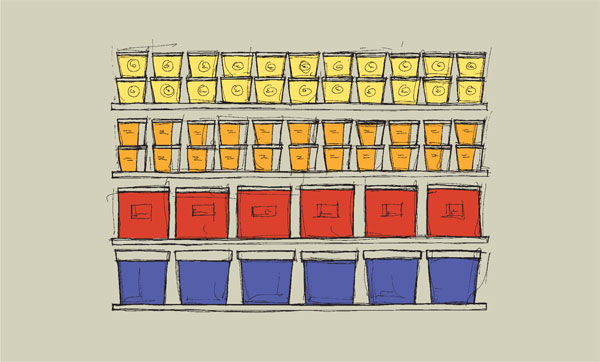
Horizontal merchandising is a simple term for products being shelved or hung horizontally from left to right. Larger items should be placed at the bottom and smaller ones at the top. It is important that shelves or rails are positioned as close to each other as possible so that there are no gaps that could weaken the impact.

Vertical merchandising is the display of product from left to right and top to bottom and, again, is suitable for clothing or houseware. It is also easy to replenish and shop.
It is good to utilize basic rules of color grouping. However, many collections today are designed with key trends in mind, in which case plain or neutral colors may integrate better with the look.
Vertical merchandising
As with horizontal merchandising, this format uses lines of products, but this time running from the top to the bottom of the wall. It can be used to show the different product options available and can be merchandised by color. As with the horizontal format, this style is easy to replenish and is functional.
Product blocking
This style of merchandising is best used for volume merchandise. Generally, a fixture or wall is stocked with just one product category or range. Product blocking shows authority and creates impact. The use of this style of merchandising is logical for the customer because it shows the colors and sizes clearly. Product-blocked fixtures are low-maintenance and easy to replenish.
Symmetrical merchandising
As the name suggests, symmetrical merchandising is a style of presenting the product to create a mirrored effect. This method is only suited to wall fixtures. The product is presented in the same way on each side, with an imaginary line running vertically through the middle. Symmetrical merchandising will require more wall space than would be necessary to show a complete product range, purely because the same product is duplicated.
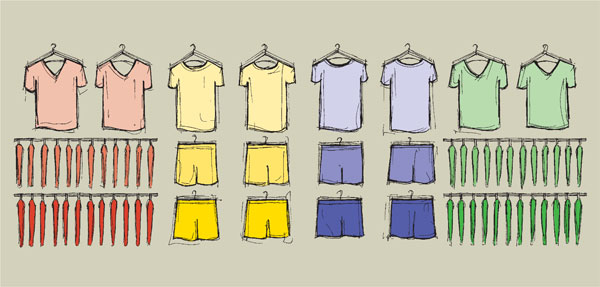
Product blocking is used here in a layout for men’s T-shirts and shorts. Brackets have been used to show face-out items, and rods used for products hung in profile. This type of display is efficient for fast-turnover products, especially for fashion items.
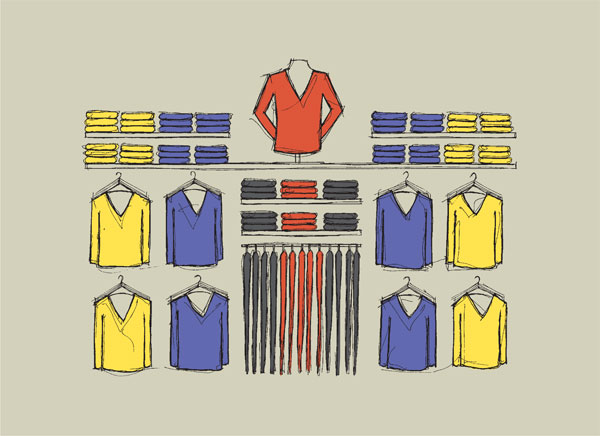
Using a wall fixture with shelving, brackets, and rods, products are displayed symmetrically. This type of display is easy to create and pleasing to the eye. The bust form can be used to draw attention to the display or to highlight an item of clothing.
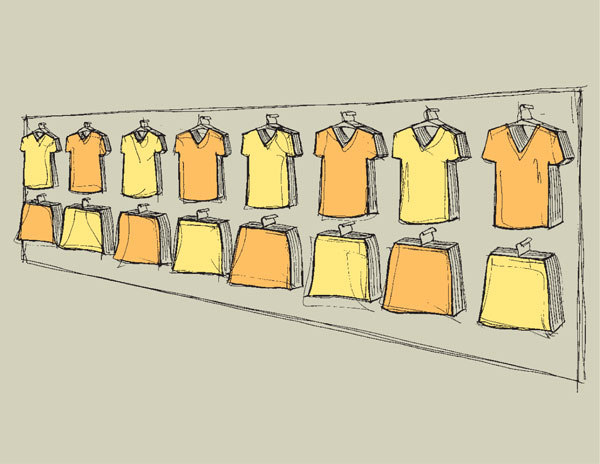
An effective use of wall space that relies solely on the merchandising to produce the effect, checkering uses two colors alternately to create a checkerboard pattern. This is useful for enlivening basics such as T-shirts and knitwear.
Checkered merchandising
Checkered merchandising is effective and easy to execute on wall fixtures. It relies on the use of color to create impact. Like a checkerboard, products are alternated along a length of wall. The overall effect should be balanced and symmetrical.

Whether on a wall or mid-floor fixture, anatomical merchandising is used to display fashion items where garments are displayed as they would be worn—such as a top displayed above pants. This type of display can be used to inspire a look or a fashion trend.
Anatomical merchandising
This style of merchandising is only suited to fashion items. The idea is to hang the garments on top of each other in the same way they would be worn: i.e. shirts under jackets. Anatomical merchandising creates complete, defined looks and can be used for mixed product types.
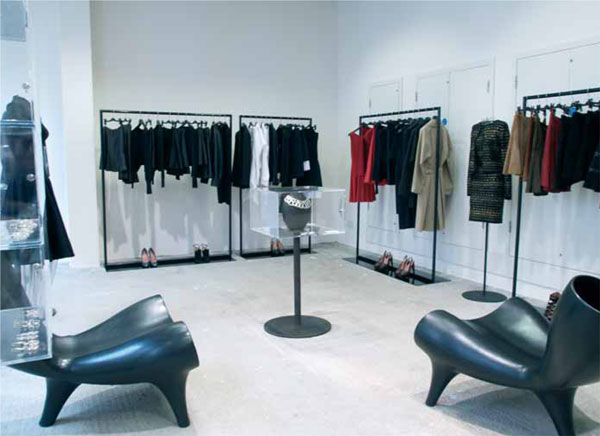
Co-ordinated merchandising is the art of placing products together in the hope that customers will buy more than one item. The aim is to create a “look” for them. Here at Dover Street Market in London, shoes, dresses, jackets, and coats are on display.
Co-ordinated merchandising
Fashion or houseware category groups benefit from using the co-ordinated merchandising technique. Collections or themes are grouped together to create a cohesive look. A jacket would be hung with a co-ordinating shirt and could be accessorized with a co-ordinated tie. A sofa could be displayed with co-ordinated items, suchs as a cushion, rug, and throw, placed on or around it.
This type of co-ordinated merchandising can also be applied to housewares. To create a co-ordinated look, you might put cushions, curtains, throws, and associated soft furnishing products together, depending on their style or trend; a traditional floral print could be broken up with plain knits and traditional stripes to create a French Provençal look, whereas muted grays and naturals could be highlighted with accent colors, such as bold pinks, reds, or blues, for a contemporary look that would suit an inner-city loft. These looks are designed to give the customer inspiration and educate them on how to put products together effectively.
Displaying product collections
The alternative to co-ordinated merchandising is to show collections that demonstrate the authority of the range in-store. Instead of dispersing candles throughout the home floor, co-ordinating them with textiles and ceramics, they can all be housed together to create an authoritative selection of varying colors, sizes, styles, and prices. This will give customers a clear understanding of the range of candles on offer but leave them to make their own selection.
